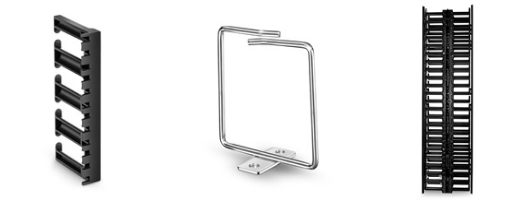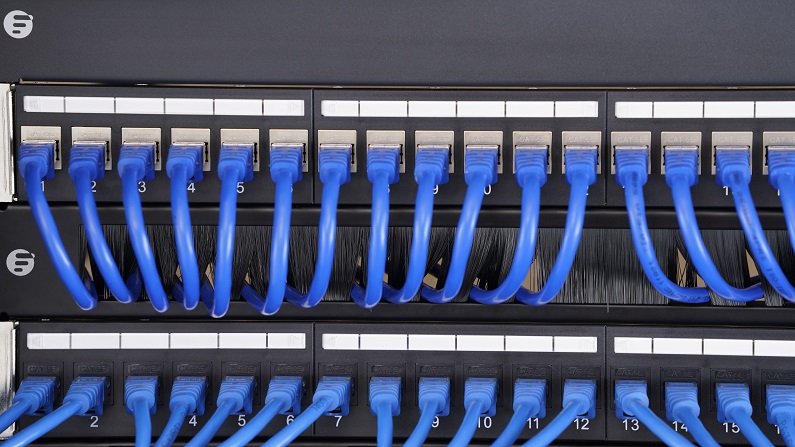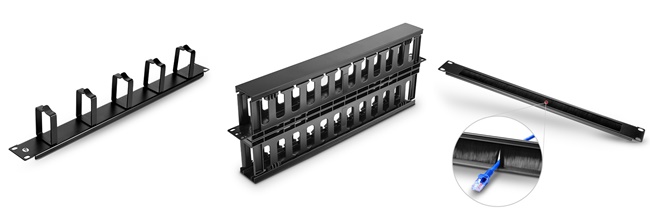With the increasing of cable counts and devices, cable management is becoming more and more complicated. An efficient network cable management not only assistants increase the flexibility of cabling, but also helps improve the operation in the data center. Therefore, a well-organized cabling has been a hot spot now. In fact, the cable management solution can be generally classified into vertical cable management and horizontal cable management. However, faced with two options, which one to choose?
What Is Vertical Cable Management?
Vertical cable management refers to a solution to secure, bundle and route the cables in a vertical pathway within the server rack. In this rack vertical cable management system, vertical cable managers offer a vertical pathway for numerous cables from switches to patch panel. These vertical wire managers are available in the height sizes up to 48U and wide up to 10 inches.
A range of vertical cable managers is provided in the market. Among them, three styles enjoy great popularity.
5U Plastic vertical cable manager with bend radius finger – The 5U cable management bend radius finger comes with rack mount enclosure, copper or fiber patch panel. It is designed to maintain cable bend radius effectively. What’s more, it enables mounting in all 19 in or 23 in EIA 2- and 4-post racks.
Single D-Ring vertical cable manager – Single D-Ring vertical cable manager features a one-piece design. It is easy to access to cables for MACs (moves, adds and changes). Besides, the 1.7’’ and 3’’ are the commonly used width size for single D-Ring vertical cable manager.
High-density vertical cable manager – The high-density vertical cable manager can be divided into single-sided version and dual-sided version. It can be mounted on the sides of open frame racks. And the 45U 4.9’’ dual-sided vertical cable manager is the most prevalent types in the market.

Figure 1: Vertical cable managers
What Is Horizontal Cable Management?
The horizontal cable management is often installed within racks or cabinets. It allows for cables to be managed on front racks or drawn away from equipment tidily. Typically, the horizontal cable management is one or two rack high, or even higher if necessary. What’s more, it enables cable managers to manage all types of cables, including fiber, coax, patch cable, etc.

Figure 2: Horizontal cable management
In the market, there are various types of horizontal cable managers, and each has its strengths for corresponding applications. In general, there are three commonly used types:
Horizontal cable manager with D-Ring – The horizontal cable manager with D-Ring is an open-access management tool. Moreover, it provides great flexibility as well. Therefore, components and cables can be easily added or removed depending on system requirements. For more information about it, please refer to How to Use D-Ring Cable Manager?
Horizontal cable manager with finger duct – When it comes to horizontal cable manager with finger duct, it is one of the most popular types of horizontal cable management solution. It provides a series of fingers and pass-through holes, which can route rack cables and reduce cable strains.
Horizontal cable manager with brush strip – Horizontal cable manager with brush strip is usually made of nylon bristles and steel. It enables cables to be passed from the front of the rack to that of the rear.

Figure 3: 1U Horizontal Cable Managers
Vertical Cable Management and Horizontal Cable Management Comparison
In terms of cable management, no matter a vertical or horizontal variety, they have some similarities. For instance, both of them contribute to network performance by enhancing airflow and cooling efficiency. And they protect cables from damages such as improper bends or dust. Moreover, the aesthetics of a data center can be improved by these managements. Actually, the two management varieties still own their individual advantages.
Reduce signal interference – The vertical cable management can separate power and data cables within the racks. Therefore, the chance for crosstalk and interference between them can be reduced greatly.
Cost effective – If vertical rack cable management with bend radius fingers is used with angled patch panel directly, you don’t have to use the horizontal cable management panel. It will reduce the cost.
Minimize downtime – When something goes wrong, it will cost hours for technicians to tracing the unorganized wires. But the downtime can’t be afforded in most cases. With horizontal cable management, cables can be arranged neatly. This makes technicians identify and maintain devices easily and quickly.
Promote growth – By using horizontal cable management, cables will no longer be messed up. It is convenient for technicians to consolidate equipment within racks or add additional racks. In addition, new ports and cables also can be added without creating problems.
Conclusion
Vertical cable management and horizontal cable management each makes a unique contribution to the data center setups. Which to choose depends on the actual needs. Sometimes, they are used as a combination. FS.COM provides all the devices mentioned above. Whatever you need to tidy up your server rack cables, welcome to visit www.fs.com.
Related Article: Guidelines for Organizing Server Rack




